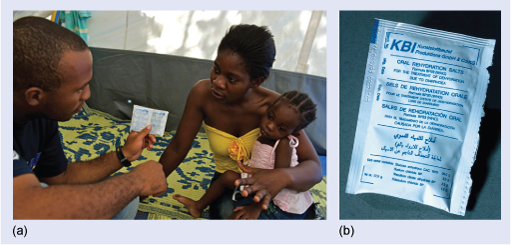4.3.1 Oral rehydration salts
The importance of community participation in the success of national campaigns to reduce the impact of diarrhoeal diseases is also illustrated by the use of oral rehydration salts (ORS) by parents all over the world to prevent dehydration in children with diarrhoea.
Many low-income countries have established national ‘Control of Diarrhoeal Diseases’ campaigns promoting the use of pre-prepared ORS sachets (over 500 million are distributed free every year), or home-made ‘water with salt and sugar’ rehydration solutions. Bangladesh was the first country to scale up oral rehydration therapy through a national programme to distribute ORS sachets to all affected households. Now many countries give parents the training and confidence as well as the ORS sachets they need to treat diarrhoea in their children (Figure 16).

However, only one-third of children with diarrhoea in LMICs receive ORS treatment when they need it. This partly explains why diarrhoea is still the second most prevalent worldwide cause of death among young children, killing about 1.4 million every year, most of them under two years of age.
Which infectious disease kills more children under five years than any other? (You may need to look back at Figure 1.)
Pneumonia is the largest killer of young children globally, causing an estimated 1.5 million deaths annually – more than HIV/AIDS, TB and malaria combined in this age group.
In the next section, many of the themes of this course are combined to illustrate the importance of community participation and low-cost interventions to the success of a major public health campaign to eliminate – and ultimately eradicate – guinea worm disease.
